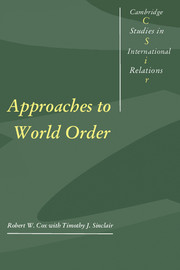Book contents
- Frontmatter
- Contents
- Preface
- Acknowledgements
- Part I Overviews
- Part II Theory
- Part III Interpretations
- Part IV Multilateralism
- 16 The executive head: an essay on leadership in international organization (1969)
- 17 Decision making (with Harold K. Jacobson) (1977)
- 18 Ideologies and the New International Economic Order: reflections on some recent literature (1979)
- 19 Labor and hegemony (1977)
- 20 Labor and hegemony: a reply (1980)
- 21 Multilateralism and world order (1992)
- 22 Globalization, multilateralism, and democracy (1992)
- Complete bibliography of works by Robert W. Cox to 1995
- Index of names
- Index of subjects
- CAMBRIDGE STUDIES IN INTERNATIONAL RELATIONS
17 - Decision making (with Harold K. Jacobson) (1977)
Published online by Cambridge University Press: 05 June 2012
- Frontmatter
- Contents
- Preface
- Acknowledgements
- Part I Overviews
- Part II Theory
- Part III Interpretations
- Part IV Multilateralism
- 16 The executive head: an essay on leadership in international organization (1969)
- 17 Decision making (with Harold K. Jacobson) (1977)
- 18 Ideologies and the New International Economic Order: reflections on some recent literature (1979)
- 19 Labor and hegemony (1977)
- 20 Labor and hegemony: a reply (1980)
- 21 Multilateralism and world order (1992)
- 22 Globalization, multilateralism, and democracy (1992)
- Complete bibliography of works by Robert W. Cox to 1995
- Index of names
- Index of subjects
- CAMBRIDGE STUDIES IN INTERNATIONAL RELATIONS
Summary
The analysis of decision making is one way of studying power relations. Decisions, of course, do not reveal power directly. What they may show directly is influence, or the way in which power is translated into action. The relative power of contending forces is an inference that can be drawn from a careful observation of the workings of influence.
In drawing this inference, one must include “non-decisions” within the concept of decisions. When an individual or group or government refrains from taking some initiative or action, this is usually because they have made a calculation showing it likely to be fruitless or possibly damaging to the attainment of their goals because it would encounter opposition too powerful to overcome. Thus, likely opposing power has been taken into account and one possible action eliminated before it ever became part of a record of visible actions. All decision makers, individual or collective, carry in their consciousness a picture of prevailing power relations, and these images of the way power is structured are initial determinants of the decision process.
The “pre-influence” stage of decision making is a mental picture of power relations.
The decision process can thus be seen as both a test of the power relations assumed at the start of the action (the mental picture), and as a means toward changing these power relations.
- Type
- Chapter
- Information
- Approaches to World Order , pp. 349 - 375Publisher: Cambridge University PressPrint publication year: 1996
- 1
- Cited by

